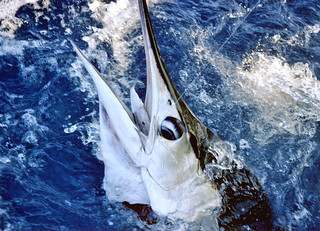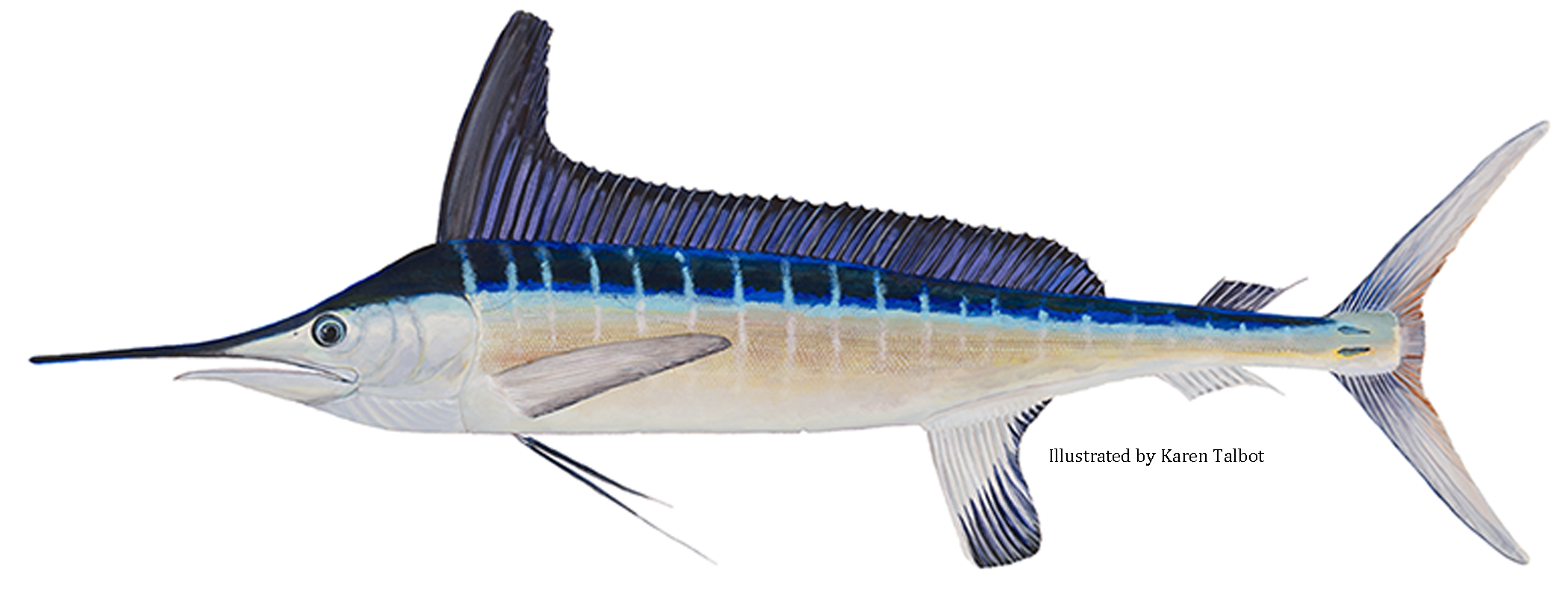There is a thriving billfish fishery off the coast of Maryland. In fact, Ocean City, Maryland is known as

the white marlin capital of the world (Marlin Magazine 2015). Every summer, as waters warm, billfish make the journey to Maryland’s offshore waters to feed. These pelagic swimmers remain off the coast until water temperatures drop again in the fall and they head back south. The four most common species are the
white marlin (Kajikia albida),
roundscale spearfish
(Tetrapturus georgii),
blue marlin (Makaira nigricans), and
Atlantic sailfish
(Istiophorus platypterus). Although keeping a billfish is
legal for recreational anglers, it is uncommon, and mostly occurs when tournament fishing. Usually, when a billfish is caught, it is quickly released.
Federal billfish permit and regulatory information are available from NOAA in
compliance guides.
Billfish - Best fishing practices video
In Maryland, when a billfish is landed, a catch card and tag are required prior to removing the fish from the vessel. Data from the
Catch Card Census Program helps the National Marine Fisheries Service and the Maryland Department of Natural Resources collect important biological information and ensure that the Atlantic quota of 250 combined white marlin, roundscale spearfish, and blue marlin is not exceeded. The International Commission for the Conservation of Atlantic Tunas recommended the quota of 250 billfish and is codified in federal regulation (NMFS 2006). Those species are prohibited for commercial harvest.
Most recreational anglers troll to catch billfish, although sight casting to fish cruising on the surface is sometimes practiced. The universal billfish bait is a rigged ballyhoo, sometimes with a rubber skirt placed over the head for more color and action, and sometimes fished bare. The use of circle hooks help to insure a quick and healthy release. Another method is trolling live baits, such as mackerel. Large plugs are also trolled. Plugs have a cupped lip, which catches and throws water. This surface disturbance is thought to entice a billfish to strike.
Identification
- Dark blue to chocolate brown on the top, fading to a silvery white on the bottom (Fish Base 2017)
- Dorsal fin is rounded, whereas the dorsal fin of a blue marlin is pointed
- First dorsal fin blue-black with small dark spots (Schulze-Haugen et al. 2003)
Size
- Generally do not exceed 5.5 feet and 80 pounds (Schulze-Haugen et al. 2003)
- Generally live to between 25 and 30 years old (Schulze-Haugen et al. 2003)
Distribution
- Throughout the Western Atlantic, from Nova Scotia to Argentina (Fish Base 2017)
Habitat
- Offshore
- Require water temperatures higher than 68 degrees (Schulze-Haugen et al. 2003)
Food Preference
- Follows warm water and forage species
- Squid, mackerels, herrings, and flying fish to name a few (Florida Museum of Natural History 2017)
Spawning
- Spawning takes place during summer months in deep blue subtropical waters (Fish Base 2017)
World Record
- 181 lbs. 14 oz. (Vitoria, Brazil) (IGFA)
Fun Fact
- Ocean City, Maryland is generally regarded to as “The White Marlin Capital of the World
Roundscale Spearfish (Tetrapturus georgii)

The roundscale spearfish, once thought to be a rare visitor to the offshore waters of Maryland, may be more common than originally thought. The roundscale spearfish is extremely similar to the white marlin, which is where the confusion begins. Both species are almost identical in size, coloration, and fin shape. They are both caught using the same techniques and are known to eat the same things.
So how do you tell the two species apart? The most reliable identification method is by determining the size of the anal fin and its distance from the anal vent. First, measure the distance between the fish’s anal vent and the front of the anal fin. Then, compare that distance to the length of the anal fin. If the distance between the anal vent and the anal fin is 50 to 75 percent of the length of the anal fin, you probably have a roundscale spearfish. If it is less than 50 percent of anal fin length, it is almost certainly a white marlin. The easier, yet not as reliable method for determining the species of a questionable fish is by comparing the measurement of anal vent to anal fin to known averages. On average, the distance between the anal vent and anal fin on a white marlin is three inches. On a roundscale spearfish, that average is much greater, usually being about six inches (NOAA 2017).
Very little is known of this species. The locations and times of year when spawning takes place are unknown. Distribution is still being determined.
Fun Fact
- The Virginia Institute of Marine Science has been analyzing and recording the DNA of billfishes caught in the Mid-Atlantic $500,000 fishing tournament since 1992. In the time period of 1992 to 2006, as many as 18 percent of "white marlin" weighed in the tournament have really been roundscale spearfish (Our New Billfish: A Rediscovery).
Blue Marlin (Makaira nigricans)
Identification
- Cobalt blue on top, fading to a silvery white on the bottom
- About 15 vertical stripes flank the body
- Dorsal and anal fins pointed (Fish Base 2017)
Size
- Largest of the billfish species found in the Atlantic
- Measuring up to 11 feet long and weighing up to 1,300 lbs (Schulze-Haugen et al. 2003)
- Rapid growth for 1-2 years – reaching 75 inches in 500 days (Schulze-Haugen et al. 2003)
Distribution
- Southern New England to southern Brazil, including Caribbean Sea and Gulf of Mexico (Schulze-Haugen et al. 2003)
Habitat
- Offshore blue waters
- Surface waters 71-88°F (Schulze-Haugen et al. 2003)
Food Preference
- Mahi mahi, tunas, mackerels, flying fish, and squid (Florida Museum of Natural History 2017)
Spawning
- Known to occur near Cuba between May and November
- A single spawn can produce up one million eggs (Florida Museum of Natural History 2017)
World Record
- 1,402 lbs. 2 oz. (Vitoria, Brazil) (IGFA 2017)
Fun Fact
- Juveniles lack the distinguishing bill seen on large fish (Schulze-Haugen et al. 2003)
Atlantic Sailfish
(Istiophorus platypterus)
 Identification
Identification
- Large sail like dorsal fin that can fold down into slot
- Dark blue on the top, fading to a silvery white on the bottom
- Vertical lines of dots running the length of the body
- The dorsal fin, or “sail”, is dark blue and covered in small black dots (Fish Base 2017)
Size
- Common size is 5.5 feet and 45 pounds (Schulze-Haugen et al. 2003)
- Grow up to 7 feet in length, and weigh up to 120 pounds (Schulze-Haugen et al. 2003)
Distribution
- Mid-Atlantic Bight to Argentina, and are also found in the entirety of the Caribbean Sea and Gulf of Mexico (Schulze-Haugen et al. 2003)
- Uncommon billfish in the blue waters offshore of Maryland
Habitat
- Coastal, offshore
- 67-82°F (Schulze-Haugen et al. 2003)
Food Preference
- Mackerels, anchovies, small tunas, and halfbeaks (Florida Museum of Natural History 2017)
Spawning
- Spawning generally occurs in the summer months
- High concentrations of spawning found off the lower east coast of Florida (Fish Base 2017)
World Record
- 142 lbs. 6 oz. (Lobito, Angola) (IGFA 2107)
Fun Fact
- There are two distinct sub-species of sailfish, the Atlantic sailfish and the Indo-Pacific sailfish (Florida Museum of Natural History 2017)
